I Will Continue to Recommend This Product to Multiple People
Digital product recommendations are the result of complex algorithmic decisions, which mine users' interactions onsite and offsite, in order to craft personalized user experiences. These experiences are built to meet shoppers' needs and demands, as well as drive engagement and revenue to boost brands' bottom lines.
Anyone who has visited an eCommerce site has likely witnessed product recommendations first hand. Powered by product recommender systems, this technology uses aggregated data, as well as predefined algorithms, to predict and present the products or services consumers are most likely to be interested in.
Today, the ability to effectively deploy product recommendations is an essential requirement for any eCommerce business that wants to increase engagement, conversions, and revenue, at scale. Below, I'll walk through must-haves for marketers looking to craft engaging recommendations and tactics they can lean on to maximize the impact of their efforts.
Product recommendation strategies
High-impact product recommendations that resonate with your visitors and drive them to convert rely on several critical factors: the optimal recommendation strategy, the current site context and user, the web page a user is browsing, and the time.
Different types of users at different stages of the customer journey call for different types of product recommendations, and identifying the right opportunities to recommend the most appropriate products for the user can either amplify the visitor experience, push the visitor to purchase and increase the total purchase value, or dissuade and distract the visitor.
Determining the correct recommendation strategy to be used in any context or location on the website is a highly calculative effort. Look for a machine-learning product recommendation engine that provides all of the following strategies out of the box:
- Automatic: Considering the context, available user data and more at a given moment this adaptive strategy automatically recommends the most appropriate products
- Similar products: Recommends items similar to the product currently being viewed
- Bought together: Recommends complementary products that are typically purchased together with the product currently in-view
- Most popular: Recommends the products that are currently most popular on a website
- Most popular in category: Recommends the products that are currently most popular within a product category currently being viewed
- User Affinity: Recommends products that match each visitor's preferences and affinities, based on browsing behavior (product views, cart additions, etc.)
- Personalized: Recommends products based on product performance per lookalike audiences and visitors
- Recently viewed: Recommends the products each visitor has recently viewed.
- Recently purchased: Showcases products typical bought with an item a customer is viewing
- Last purchased:Showcases items from a customer's most recent purchase
- Purchased with recent purchase:Recommends products typically bought with an item a user has recently purchased
- Viewed with recently viewed items : Suggests products similar to items a user has recently viewed
- Hybrid strategies: Any combination of the above strategies
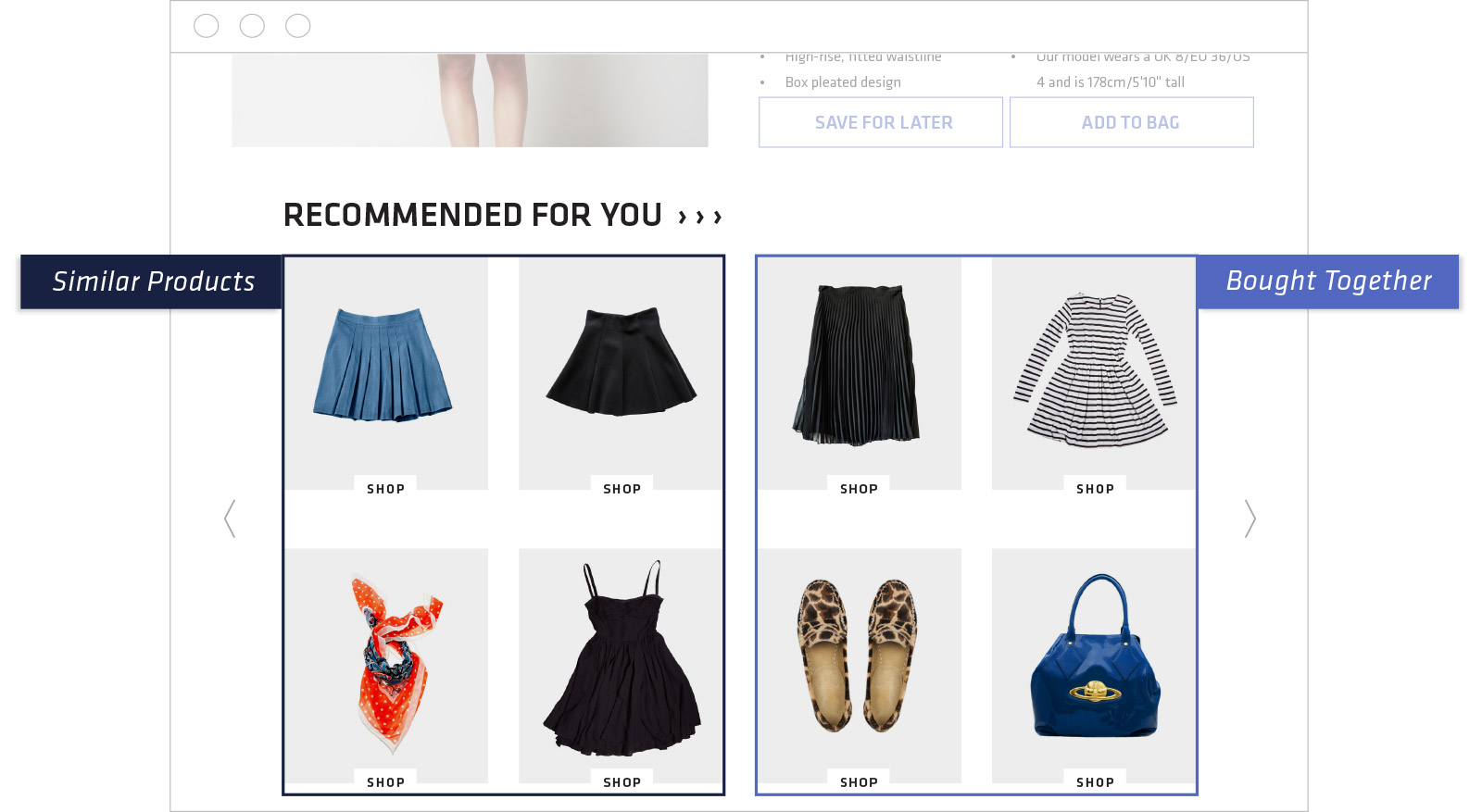
Product recommendations example from an online fashion retailer: Using hybrid strategies to display "Similar Products" and "Bought Together" recommendations on one product detail page.
Recommendation strategies by page context
Product recommendations are commonly implemented on the homepage, product listing pages (PLPs) or category pages, product detail pages (PDPs), cart pages, or between any of these stages by means of overlays and popups. Different recommendation strategies can be chosen and optimized for each of these specific page contexts, maximizing potential revenue. Below is a breakdown of proven recommendation guidelines according to page context.
Homepage
Recommendations on the homepage, which is the main point of entry for site visitors, often tap the "Most Popular" strategy, which showcases best sellers to new site visitors. For returning visitors, use a personalized strategy, such as an affinity-based or recently viewed strategy, to quickly and easily guide users toward products they've previously shown interest in.
Category pages
For these pages, the "Most Popular in Category" is a great strategy to use to surface products for both new and "Personalized"/"User Affinity" are the only options to consider in this case. We recommend always serving personalized strategies to returning visitors and falling back to the global, popularity-based strategies for new visitors.
Product detail pages
"Similar Products" and "Bought Together" are the best options for product detail pages (PDPs). If only one recommendation unit or strategy can be implemented, choose "Similar Products" as case studies have revealed that this strategy tends to play a more integral role in visitors' decision-making process when deciding to purchase a product. "Bought Together" is a relevant strategy as well, but usually performs best when introduced after the current product has been added to the cart. If a "Just Added" recommendation widget can be deployed via popup after a user adds an item to their cart, consider using the "Bought Together" strategy in order to drive up your average order value (AOV).
Cart pages
"Bought Together" is a great choice for cart pages, especially for marketers looking to showcase products that are slightly cheaper than those in a user's cart. It empowers users to make quick purchase decisions, often resulting in upsells. Depending on the nature of the products, if your site analytics reveal that similar products are often purchased together, the "Similar Products" strategy can be layered atop the "Bought Together" strategy to recommend similar products a user may be interested in.
Recommendations everywhere
Realistically, marketers must be able to place recommendation widgets on any site page. Based on your needs and objectives, test different strategies, layouts, and placements across your site to find what works best for your business, and experiment with exit-intent popups, null search results pages, theme-based landing pages, emails, and more.
Recommendation strategies by audience
No single strategy will suit all site visitors. Some consumers may browse your site several times a week, while others may be first-time visitors who have arrived via a search engine query.
The best product recommendation engines are able to assess what's known about a particular visitor and deploy the most appropriate strategy based on data availability, context, user behavior and more to drive user action.
For example, visitors with low data availability (new users) will receive generic ranking recommendations such as "Most Popular." Consumers with a history of purchasing or viewing items should be served with contextually-driven product recommendations. Loyal consumers, on the other hand, have rich user profiles available, making them ideal candidates for personalized recommendations, such as "Recommended for you" widgets throughout the site.
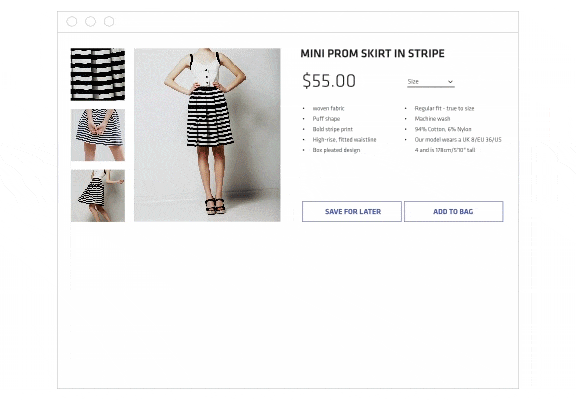
An example of how automated strategy selection may serve different recommendations to various types of users can be illustrated in the table below:
Additionally, any recommendation widget can have numerous merchandising rules worked into its logic, which allows for micro-segmentation. For example, determining that visitors in the Men's and Women's Audiences should only see Men's and Women's products, respectively, while making sure kids' products are recommended to visitors with children in the household are important merchandising rules that should be prioritized when building a new experience.
Setting up merchandising rules according to audience
Although automated algorithms have a strong track record, your merchandisers have tremendous expertise and insight into your customers. For this reason, your product recommendation engine must be flexible and support manual merchandising rules, such as pinning a specific item or including / excluding a particular set of items from the automated recommendation results. For example, merchandisers can set rules that inform the product recommendations engine to:
- Include popular items in a product category a consumer has viewed over a set period of time (e.g. display of a popular item in "mens' shorts" to a visitor who has viewed at least two pairs of mens' shorts in the past 30 days)
- Recommend highly profitable items to consumers who have purchased or added to their carts items valued at $200 or more in the past 7 days
- Refrain from displaying clearance items promoted in other areas of the brand's site to high-value customers
- Create more granular rules to accomplish specific business goals, such as moving remnant stock or slow-moving inventory.
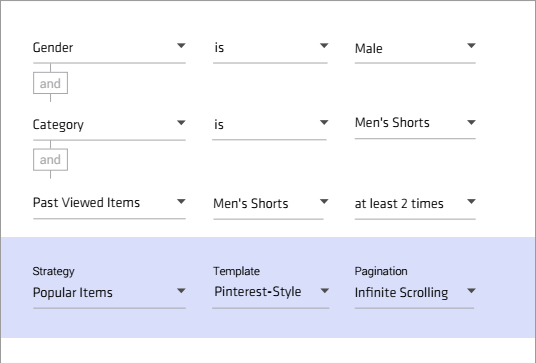
Best practices for maximizing the impact of product recommendations
Now that you're armed with the essential knowledge needed for deploying recommendations, I'm going to share a handful of tips and best practices for marketers looking to maximize the impact of every recommendation widget deployed, helping them stretch their marketing dollars and create pleasant user experiences for each and every site visitor.
Removing product prices from email product recommendations
Email marketing and newsletters have one purpose – to bring traffic back to the website. Therefore, content and detailed specifications that cause the recipient to think and calculate before they return to a site should be avoided. Price, especially when high, will often scare off and deter an email recipient. High-res images, high-ranking and favorable reviews will grab users' attention, eventually drawing them back to the site.
Engaging side-door traffic
Referral and search traffic that arrive directly on a specific category or product page often provide a fleeting opportunity to engage a site visitor. And more times than not, brands miss their chance to capture users' attention, resulting in a page bounce. To avoid this, marketers need to entice users to stay on-site longer by surfacing similar products to the one in view. To do so, expose this traffic – known as side-door traffic – to a variety of relevant, captivating products. This can be achieved by:
- Introducing product recommendations at the top of the page for users from this traffic source
- Serve product recommendations using a Pinterest-like widget design below the main featured product on the PDP, which encourages users to scroll down and browse more products without having to leave the page
Setting up unique merchandising rules for different audience segments
Demographic, geographic, and behavioral data are all high-value data points that should be leveraged in product recommendations. With data available on each and every customer, create merchandising rules that will help better tailor their site experiences. For example, if the weather is cold right now in Boston, you can create rules that will automatically recommend winter apparel to Bostonians. Additionally, depending on the available data, the system can create more granular recommendations according to other user identifiers, such as gender, household income, brand affinities, and more.
Tailoring category pages by audience segment
No one visitor is like the other, and every visitor makes his or her product selections differently. The purpose of a category page is to showcase the entire selection of products in a specified category, which often results in displaying hundreds of products.
Expecting visitors to easily make a selection shortly after arriving on a category page is unrealistic. In fact, the process of browsing through page after page is often discouraging, causing users to give up and walk away, leaving your site more overwhelmed or lost than they were when they began their search for a product. Even if you offer product discovery tools, such as faceted search, sorting options, and a search option, visitors often continue to face choice paralysis from the number of product options available to them.
A page's layout and the methodology behind how products are sorted on a category page are essential elements of the site experience. In fact, case studies reveal that over 70% of products purchased by visitors who browse category pages appear in the first two rows. Visitors who did not find what they were looking for in the first few rows and scrolled down the page had a much lower probability of completing a purchase.
Personalizing category and grid pages guarantees that each and every visitor is exposed to the products that interest him or her the most, driving add-to-carts and decreasing bounce rates.
For example, using the user affinity recommendation strategy, marketers can tailor category pages. The system will display relevant SKUs according to the visitor's preferences, allowing you to automatically sort the page according to the visitors' affinity profiles.
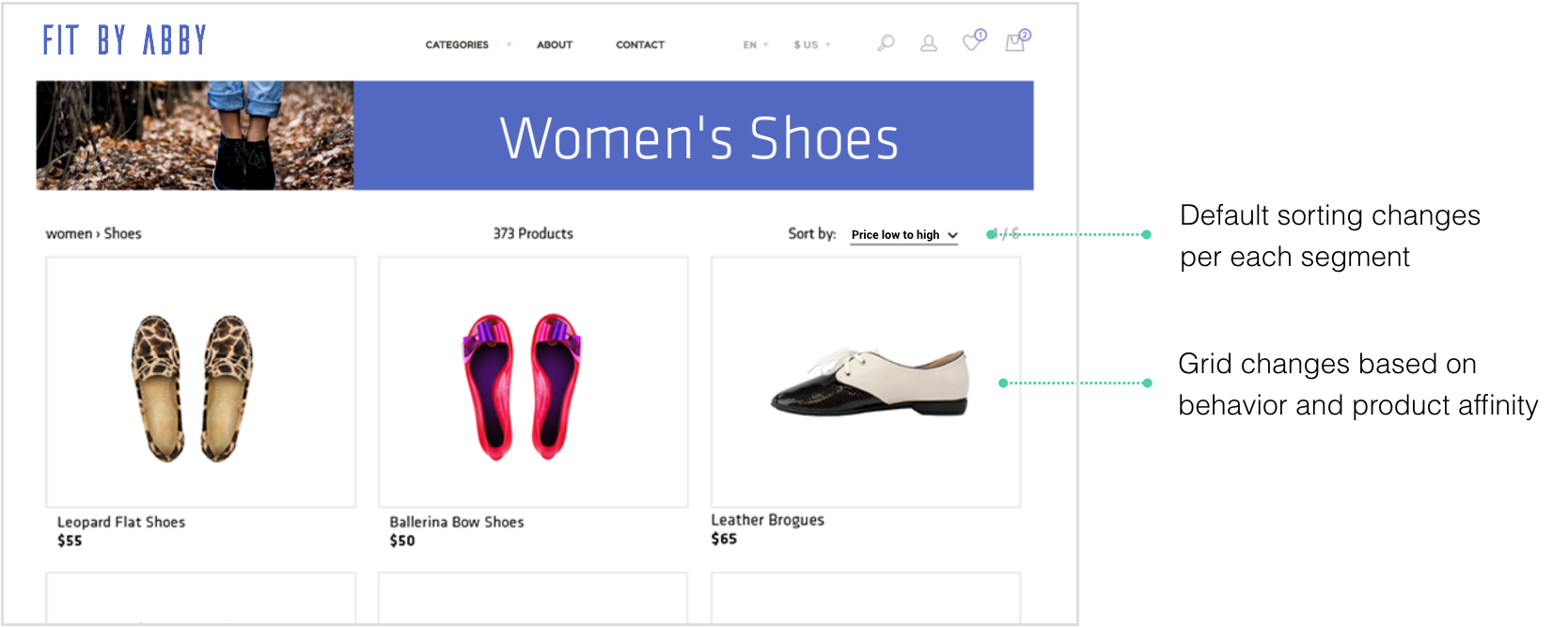
Merchandising discounted items
Everyone is interested in reduced-price items, including your most loyal heavy shoppers who are happy to inflate their cart with additional sale items, together with the full-priced items they've selected. Since sale items are relevant to everyone, they should be recommended – anywhere on the site. Contrary to some schools of thought, there is no reason to restrict sale items only to the Sale and Outlet sections of the site – doing so can significantly limit your AOV and conversion rate.
Recommending similar products on the cart page
As previously mentioned, an optimal recommendation strategy for Cart pages is "Bought Together," which recommends complementary products to those currently in a user's cart.
However, your site analytics may reveal that your customers often purchase two or three products from the same product family. Often observed when purchasing apparel, groceries, home goods, or sporting goods, capitalize on this behavior by deploying recommendations on the cart page. Suggest similar products to upsell customers while they are reviewing items in their cart or present users with the option to increase the quantity of one item in their cart if they want to stock up in advance.
Featuring recommendations across all pages and channels
Don't limit your recommendations to the bottom of your Product pages; include them in newsletters, digital receipts, designated landing pages, your native mobile apps (and using geo-location data, deploy push notifications to serve consumers recommendations while they are in brick-and-mortar stores), product ads, navigation menus, welcome messages, and exit-intent popups.

Product recommendations example from a large eCommerce brand: Serving personalized product recommendations with relevant popups upon exit intent.
Optimizing the layout of product recommendation widgets
Product recommendations aren't always made in a rotating carousel laid out in one row. In fact, there is no single, optimal template, and optimizing the look and feel of your product recommendations can make a world of difference – especially on mobile web and native apps.
Marketers need the flexibility to alter, change and customize the layout and functionality of every widget. Look for a product recommendation engine that allows you to incorporate tests and personalization tactics that position recommendations in different areas of the page and site for different audiences and also allow you to alter the layout or recommendations according to every visitor type.
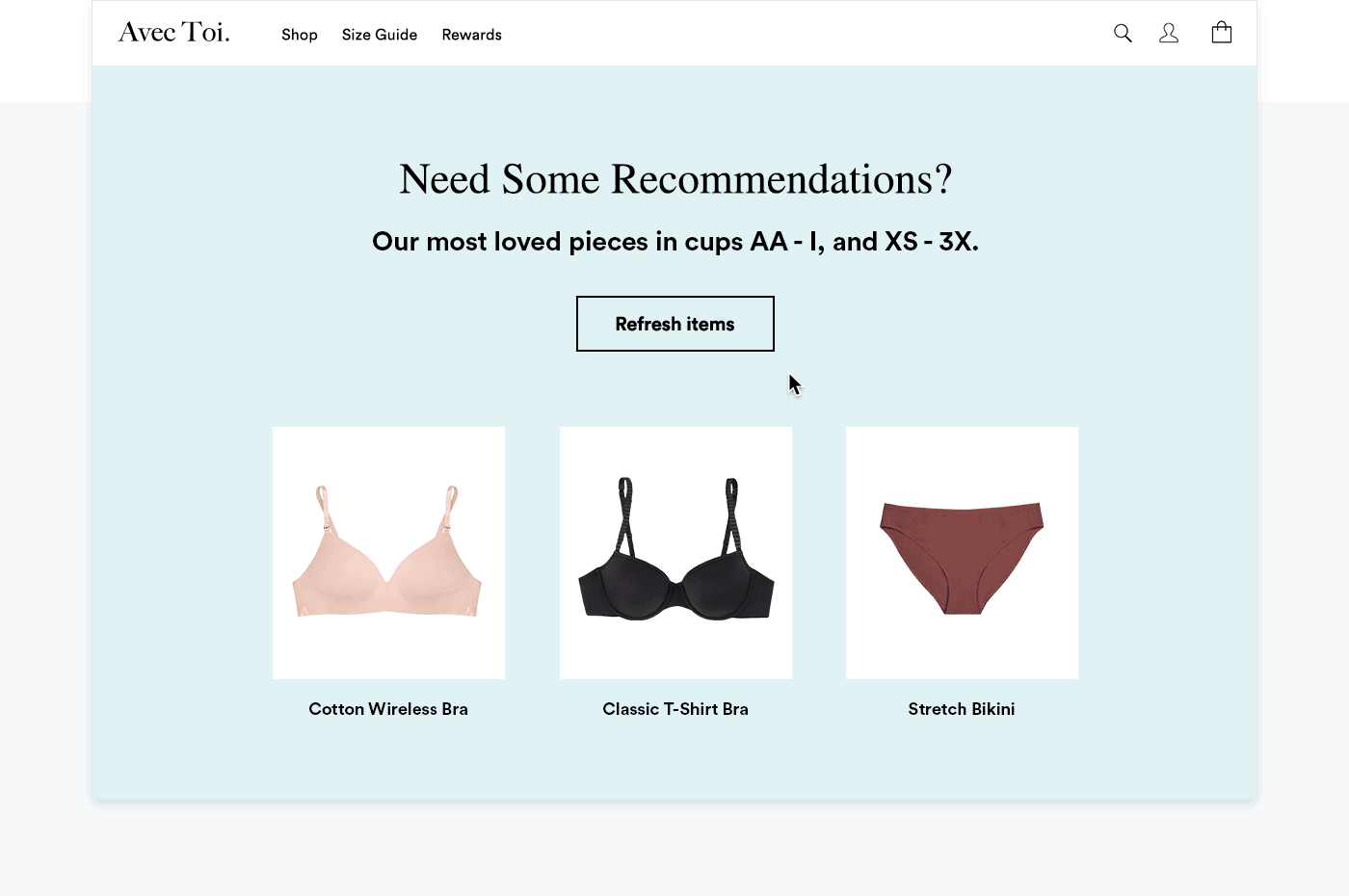
Product recommendations example from an innovative eCommerce brand: Gamifying the product recommendations strategy creating a slot machine-inspired experience.
Experimenting and testing new recommendation campaigns
A/B testing different recommendation strategies will come in handy when looking to understand which recommendation strategy is working best. It will allow you to refine and increase the impact of every campaign in real-time and identify key insights and learnings for the long-term. And incorporating different merchandising rules will further enhance your experimentation capabilities, allowing you to identify key opportunities for revenue generation. Be sure to harness user data to effectively segment audiences and build new experiences that will suit consumers and reach them where they are, ensuring they are always recommended products they've expressed interest or are likely interested in. Remember: the more personalized the site experience, the more likely a consumer is to convert (and come back).
Recommendations are your key to revenue generation
Product recommendation strategies vary greatly from one another, and experimenting with strategies will help improve revenue and create richer experiences. By remaining nimble, testing different placements, and analyzing performance data, refine your overall strategy to better tailor the site experience for every user. And once you're comfortable, play with advanced settings, segmentation strategies, and merchandising rules to extract the highest value from every audience segment to start realizing your highest ROI.
Continue reading
Source: https://www.dynamicyield.com/lesson/product-recommendations-guide/